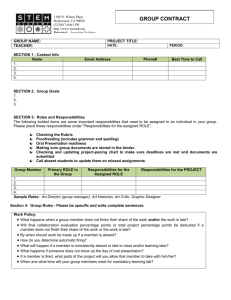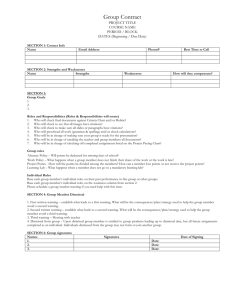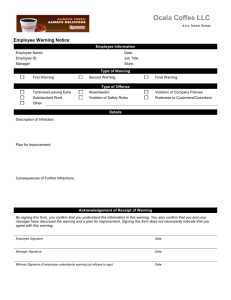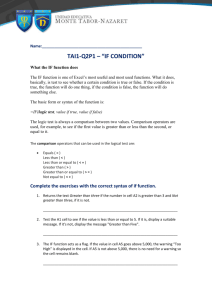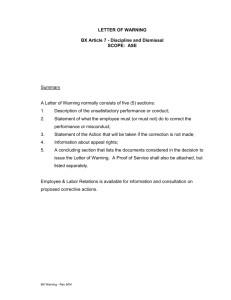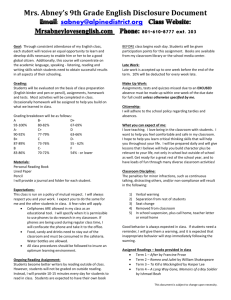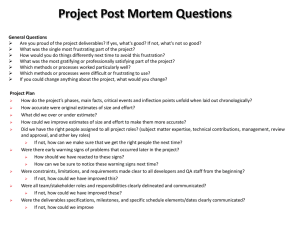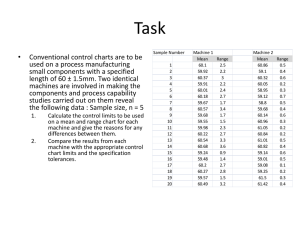Information Technology Risk Warning Signs ()
advertisement
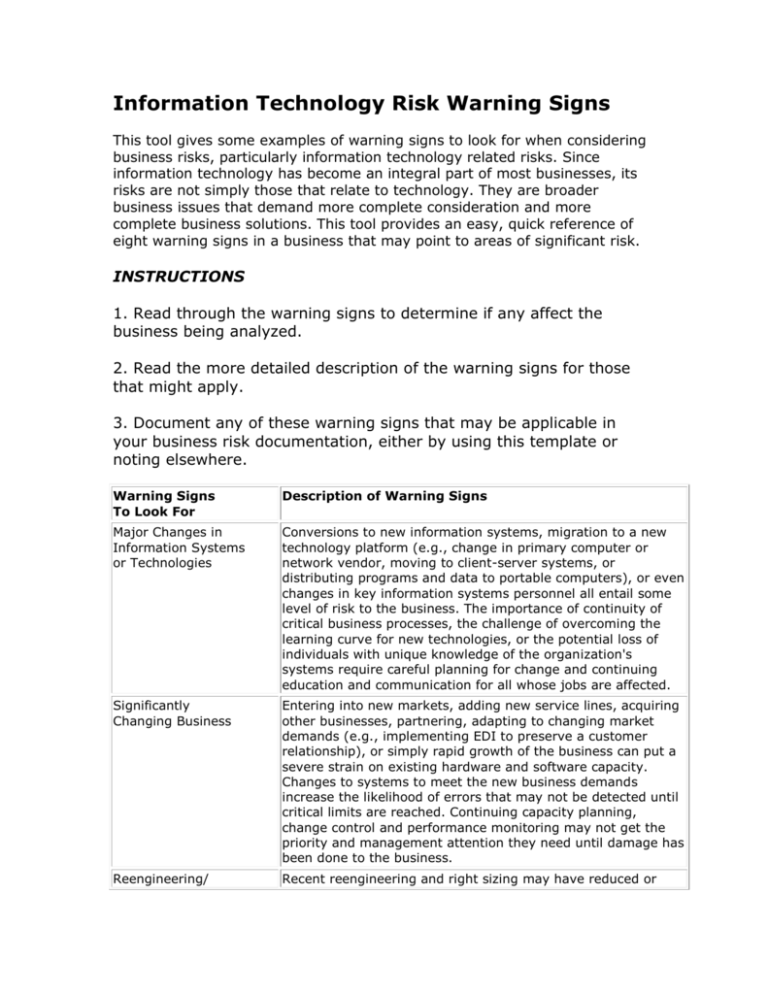
Information Technology Risk Warning Signs This tool gives some examples of warning signs to look for when considering business risks, particularly information technology related risks. Since information technology has become an integral part of most businesses, its risks are not simply those that relate to technology. They are broader business issues that demand more complete consideration and more complete business solutions. This tool provides an easy, quick reference of eight warning signs in a business that may point to areas of significant risk. INSTRUCTIONS 1. Read through the warning signs to determine if any affect the business being analyzed. 2. Read the more detailed description of the warning signs for those that might apply. 3. Document any of these warning signs that may be applicable in your business risk documentation, either by using this template or noting elsewhere. Warning Signs To Look For Description of Warning Signs Major Changes in Information Systems or Technologies Conversions to new information systems, migration to a new technology platform (e.g., change in primary computer or network vendor, moving to client-server systems, or distributing programs and data to portable computers), or even changes in key information systems personnel all entail some level of risk to the business. The importance of continuity of critical business processes, the challenge of overcoming the learning curve for new technologies, or the potential loss of individuals with unique knowledge of the organization's systems require careful planning for change and continuing education and communication for all whose jobs are affected. Significantly Changing Business Entering into new markets, adding new service lines, acquiring other businesses, partnering, adapting to changing market demands (e.g., implementing EDI to preserve a customer relationship), or simply rapid growth of the business can put a severe strain on existing hardware and software capacity. Changes to systems to meet the new business demands increase the likelihood of errors that may not be detected until critical limits are reached. Continuing capacity planning, change control and performance monitoring may not get the priority and management attention they need until damage has been done to the business. Reengineering/ Recent reengineering and right sizing may have reduced or Right Sizing eliminated some internal controls such as segregation of duties, supervision and review. The changes to information systems that were an essential part of the reengineering could exacerbate the weakening of internal control, allowing material errors to slip through or opening opportunities for fraudulent misuse of the systems. Open Access to Systems and Data Allowing unauthorized employees access to critical data or not restricting employees' access to data that they do not need reduces data integrity. The risk is twofold. First, there is the risk that unauthorized employees can read and make copies of proprietary or confidential data and knowingly or accidentally disclose this data to customers or competitors. Second, there is the risk that unauthorized employees can initiate transactions or make direct changes to data which could result in incomplete and inaccurate data. At best, this affects the integrity and reliability of information; at worst it may be done for purposes of fraud. Risk examples include unauthorized transactions or alterations to pricing, discounts, payment authorizations, vendor addresses, inventory quantities and cost information Physical Security of Computer Hardware and Software Data integrity cannot exist without physical security over computer hardware and software. Access to file servers and other sensitive systems components must be restricted. Significant Ad hoc Reporting for Critical Data Data integrity is vital for the decision making process and the continued survival of the business. Ad hoc reporting requires human intervention or processing which may lead to intentional or unintentional errors in the data. Therefore, a significant amount of ad hoc reporting for critical data may result in lower levels of data integrity. Excessive Systems Errors, Crashes, or Similar Problems Excessive systems errors or systems crashes and downtime typically are signs that a system has been implemented without adequate capacity planning, systems testing, or ongoing monitoring. The business impact may be felt in a loss of information integrity or the unavailability of information and processing to support critical business activities. General System Complaints by Users General complaints by users about the system can be warning signs that the system is not working well and, therefore may mean that the data may not be reliable. Examples may be complaints that users cannot get the information they need out of the system, the reports they are getting are incorrect, or the system is not doing what they expected. Source http://www.knowledgeleader.com/iafreewebsite.nsf/content/TechnologyAuditITRiskWar ningSigns!OpenDocument


